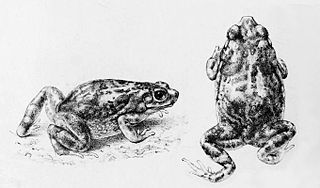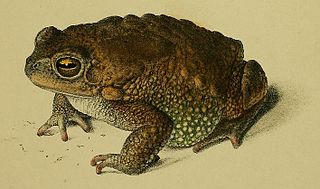
Duttaphrynus melanostictus is commonly called Asian common toad, Asian black-spined toad, Asian toad, black-spectacled toad, common Sunda toad, and Javanese toad. It is probably a complex of more than one true toad species that is widely distributed in South and Southeast Asia.
The Sumatra toad, Duttaphrynus sumatranus, is a species of toad endemic to Sumatra, Indonesia, and only known from Lubuk Selasi. It has been found along a small, clear stream in secondary forest. It is locally common but listed as a critically endangered species due to a restricted range and continuing habitat loss.

Duttaphrynus parietalis, commonly known as the Indian toad or ridged toad, is a species of toad found in the Western Ghats of India.

Duttaphrynus stomaticus, also known as the Indian marbled toad, Punjab toad, Indus Valley toad, or marbled toad, is a species of toad found in Asia from eastern Iran, Pakistan, Afghanistan to Nepal, extending into Peninsular India and Bangladesh.

Duttaphrynus microtympanum is a species of toad found in the Western Ghats of India, possibly wider.

Duttaphrynus himalayanus, also known as the Himalaya toad, Himalayan toad, Himalayan broad-skulled toad, and Günther's high altitude toad, is a species of toad that is widely distributed throughout the Himalayan mountains. The Yunnanese populations are sometimes considered a separate species, Duttaphrynus cyphosus.

Duttaphrynus beddomii is a species of toad endemic to the Western Ghats of India. It is found in Kerala and Tamil Nadu states in the southern Western Ghats at elevations of 100–1,500 m (330–4,920 ft) asl.

Duttaphrynus hololius, known as Günther's toad, Malabar toad, or rock toad, is an uncommon, rock-dwelling toad found in the Eastern Ghats and Deccan plateau of peninsular India.

Ghatophryne rubigina is a species of toad in the family Bufonidae. It is endemic to the southern Western Ghats, India, and is known from Silent Valley and Wynaad, both in Kerala. Its common names include Kerala stream toad, Silent Valley torrent toad, and red torrent toad.

The Arabian toad is a species of toad in the family Bufonidae. It is endemic to the Arabian Peninsula and is found in Oman, Saudi Arabia, the United Arab Emirates, and Yemen.

Duttaphrynus atukoralei is a species of toad in the family Bufonidae. It is endemic to Sri Lanka where it is found on the coastal lowlands of southern half of Sri Lanka below 200 m (660 ft) asl.
Duttaphrynus brevirostris is a species of toad in the family Bufonidae. It is endemic to the Western Ghats of India and only known from its type locality, Kempholey in Hassan district, Karnataka. The elevation is believed to have been about 200–300 m (660–980 ft) asl. It is known only from the now lost holotype, and nothing is known about its habitat or ecology.
Duttaphrynus crocus is a species of toads in the family Bufonidae endemic to the Rakhine State, Myanmar. Its natural habitat is primary evergreen forest. It is threatened by habitat loss (logging).
The Dhofar toad or Oman toad, Duttaphrynus dhufarensis, is a species of toad in the family Bufonidae. It is endemic to the Arabian Peninsula and is found in Oman, Saudi Arabia, the United Arab Emirates, and Yemen.

Duttaphrynus kotagamai is a species of toad in the family Bufonidae endemic to Sri Lanka. Its natural habitats are tropical moist lowland forests, moist montane forests, and rivers. It is threatened by habitat loss. D. kotagamaii is named after Sarath Kotagama. A grown male is 33–40 mm in length, while a female reaches 55–63 mm. It is nocturnal, and lives commonly under rocks or decomposed leaves. It is found in Massena, Kitulgala, and Singharaja forests. Its diet consists of termites and grasshoppers. Its breeding biology has not been recorded, but it presumably takes place in water, probably in streams.

Duttaphrynus noellerti is a species of toads in the family Bufonidae. It is endemic to the rainforests of southwestern Sri Lanka. It is named after Andreas Nöllert, a German herpetologist and photographer who first noted the distinctiveness of the species.

Duttaphrynus olivaceus is a species of toad in the family Bufonidae. It is found in southeastern Iran and western Pakistan. Its presence in Afghanistan and India is doubtful. Common names olive toad, Baluchistan coastal toad, Baluchestan coastal toad, and Makran toad have been coined for it.

Duttaphrynus scaber is a species of toad in the family Bufonidae. It is found in peninsular India and Sri Lanka. Bufo fergusonii, now synonymized with Duttaphrynus scaber, was named after Harold S. Ferguson who collected the type specimen.

Duttaphrynus valhallae is a species of toad in the family Bufonidae. It is endemic to Weh Island, located northwest of Sumatra, Indonesia. Known only from the holotype, its ecology is unknown, but it is assumed to be a lowland forest species. Practically no forest habitat remains on Weh Island, and it is not known whether the species still persists there. Also its taxonomic validity is uncertain.

Oligodon fasciolatus, commonly known as the small-banded kukri snake or the fasciolated kukri snake, is a species of snake in the family Colubridae. The species is native to Southeast Asia. This snake uniquely eviscerates poisonous toads to avoid the toad's venom.
















